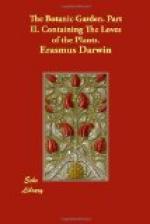Effects of opium
Frontispiece by Miss Crewe
Petals of Cistus and Oenanthe continue but a few hours
Method of collecting the gum from Cistus by leathern throngs
Discovery of the Bark
Foxglove how used in Dropsies
Bishop of Marseilles, and Lord Mayor of London
Superstitious uses of plants, the divining rod, animal magnetism
Intoxication of the Pythian Priestess, poison from Laurel-leaves, and from cherry-kernels
Sleep consists in the abolition of voluntary power; nightmare explained
Indian fig emits slender cords from its summit
Cave of Thor in Derbyshire, and sub-terraneous rivers explained
The capsule of the Geranium makes a hygrometer; Barley creeps out of a barn Mr. Edgeworth’s creeping hygrometer
Flower of Fraxinella flashes on the approach of a candle
Essential oils narcotic, poisonous, deleterious to insects
Dew-drops from Mancinella blister the skin
Uses of poisonous juices in the vegetable economy
The fragrance of plants a part of their defence
The sting and poison of a nettle
Vapour from Lobelia suffocative; unwholesomness of perfumed hair-powder
Ruins of Palmira
The poison-tree of Java
Tulip roots die annually
Hyacinth and Ranunculus roots
Vegetable contest for air and light
Some voluble stems turn E.S.W. and others W.S.E.
Tops of white Bryony as grateful as asparagus
Fermentation converts sugar into spirit, food into poison
Fable of Prometheus applied to dram-drinkers
Cyclamen buries its seeds and trifolium subterraneum
Pits dug to receive the dead in the plague
Lakes of America consist of fresh water
The seeds of Cassia and some others are carried from America, and thrown on the coasts of Norway and Scotland
Of the gulf-stream
Wonderful change predicted in the gulph of Mexico
In the flowers of Cactus grandiflorus and Cistus some of the stamens are perpetually bent to the pistil
Nyctanthes and others are only fragrant in the night; Cucurbita lagenaria closes when the sun shines on it
Tropeolum, nasturtian, emits sparks in the twilight
Nectary on its calyx
Phosphorescent lights in the evening
Hot embers eaten by bull-frogs
Long filaments of grasses, the cause of bad seed-wheat
Chinese hemp grew in England above 14 feet in five months
Roots of snow-drop and hyacinth insipid like orchis
Orchis will ripen its seeds if the new bulb be cut off
Proliferous flowers
The wax on the candle-berry myrtle said to be made by insects
The warm springs of matlock produced by the condensation of steam raised from great depths by subterranean fires




